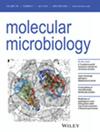Heterologous Surface Display Reveals Conserved Complement Inhibition and Functional Diversification of Borrelia burgdorferi Elp Proteins
IF 2.6
2区 生物学
Q3 BIOCHEMISTRY & MOLECULAR BIOLOGY
引用次数: 0
Abstract
Lyme disease is a tick-borne spirochetosis with diverse clinical manifestations. Genotypic and phenotypic variation among Borrelia burgdorferi strains correlates with variable manifestations of Lyme disease in humans; this diversity is attributed in part to variation in surface-exposed lipoproteins, which are targets of the human antibody response and contribute to tissue adhesion, immune evasion, and other host interactions. Many B. burgdorferi lipoproteins are encoded as multi-copy gene families, such as the OspE/F-like leader peptide (Elp) protein family, which inhibits classical complement activation by binding complement C1s. To characterize Elp allelic variants, we adapted the Pseudomonas syringae ice nucleation protein (INP) system to present B. burgdorferi lipoproteins on the surface of Escherichia coli. Using this system, we identified interactions with classical complement proteins and mapped binding regions, then validated interactions using recombinant proteins and B. burgdorferi surface display. We also discovered a novel potential interaction between Elp proteins and the mammalian basement membrane protein perlecan, thus revealing a bifunctional nature of Elps. Our findings indicate that Elps have undergone functional diversification while maintaining classical complement inhibition mediated by potent and conserved C1s binding and demonstrate that E. coli surface display offers an efficient, cost-effective, and relatively high-throughput approach to characterize B. burgdorferi lipoproteins.

异源表面展示揭示伯氏疏螺旋体Elp蛋白的保守补体抑制和功能多样化
莱姆病是一种蜱传螺旋体病,临床表现多样。伯氏疏螺旋体基因型和表型变异与人类莱姆病的不同表现相关这种多样性部分归因于表面暴露脂蛋白的变化,这是人类抗体反应的靶标,有助于组织粘附、免疫逃避和其他宿主相互作用。许多伯氏疏螺旋体脂蛋白被编码为多拷贝基因家族,如OspE/ f样前导肽(Elp)蛋白家族,其通过结合补体C1s抑制经典补体激活。为了表征Elp等位基因变异,我们采用丁香假单胞菌冰核蛋白(INP)系统在大肠杆菌表面呈现伯氏疏螺旋体脂蛋白。利用该系统,我们确定了与经典补体蛋白的相互作用,并绘制了结合区域,然后利用重组蛋白和伯氏疏螺旋体表面展示验证了相互作用。我们还发现了Elps蛋白与哺乳动物基底膜蛋白perlecan之间的一种新的潜在相互作用,从而揭示了Elps的双功能性质。我们的研究结果表明,Elps经历了功能多样化,同时保持了由强效和保守的C1s结合介导的经典补体抑制,并表明大肠杆菌表面展示提供了一种高效、经济、相对高通量的方法来表征伯氏疏螺旋体脂蛋白。
本文章由计算机程序翻译,如有差异,请以英文原文为准。
求助全文
约1分钟内获得全文
求助全文
来源期刊

Molecular Microbiology
生物-生化与分子生物学
CiteScore
7.20
自引率
5.60%
发文量
132
审稿时长
1.7 months
期刊介绍:
Molecular Microbiology, the leading primary journal in the microbial sciences, publishes molecular studies of Bacteria, Archaea, eukaryotic microorganisms, and their viruses.
Research papers should lead to a deeper understanding of the molecular principles underlying basic physiological processes or mechanisms. Appropriate topics include gene expression and regulation, pathogenicity and virulence, physiology and metabolism, synthesis of macromolecules (proteins, nucleic acids, lipids, polysaccharides, etc), cell biology and subcellular organization, membrane biogenesis and function, traffic and transport, cell-cell communication and signalling pathways, evolution and gene transfer. Articles focused on host responses (cellular or immunological) to pathogens or on microbial ecology should be directed to our sister journals Cellular Microbiology and Environmental Microbiology, respectively.
 求助内容:
求助内容: 应助结果提醒方式:
应助结果提醒方式:


